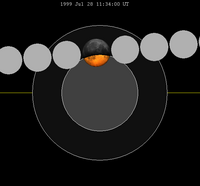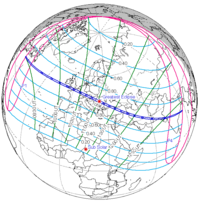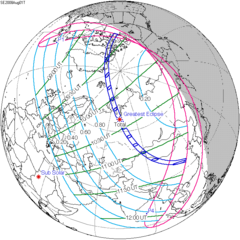July 1999 lunar eclipse
| Partial eclipse | |||||||||||||
 The Moon's hourly motion shown right to left | |||||||||||||
| Date | July 28, 1999 | ||||||||||||
|---|---|---|---|---|---|---|---|---|---|---|---|---|---|
| Gamma | 0.7863 | ||||||||||||
| Magnitude | 0.3966 | ||||||||||||
| Saros cycle | 119 (61 of 83) | ||||||||||||
| Partiality | 142 minutes, 32 seconds | ||||||||||||
| Penumbral | 310 minutes, 56 seconds | ||||||||||||
| |||||||||||||
A partial lunar eclipse occurred at the Moon’s descending node of orbit on Wednesday, July 28, 1999,[1] with an umbral magnitude of 0.3966. A lunar eclipse occurs when the Moon moves into the Earth's shadow, causing the Moon to be darkened. A partial lunar eclipse occurs when one part of the Moon is in the Earth's umbra, while the other part is in the Earth's penumbra. Unlike a solar eclipse, which can only be viewed from a relatively small area of the world, a lunar eclipse may be viewed from anywhere on the night side of Earth. Occurring about 5.2 days after apogee (on July 23, 1999, at 6:45 UTC), the Moon's apparent diameter was smaller.[2]
Visibility
The eclipse was completely visible over eastern Australia, Antarctica, and much of the Pacific Ocean, seen rising over east and southeast Asia and western Australia and setting over much of North and South America.[3]
 
|
Eclipse details
Shown below is a table displaying details about this particular solar eclipse. It describes various parameters pertaining to this eclipse.[4]
| Parameter | Value |
|---|---|
| Penumbral Magnitude | 1.43423 |
| Umbral Magnitude | 0.39658 |
| Gamma | 0.78630 |
| Sun Right Ascension | 08h29m15.8s |
| Sun Declination | +19°01'23.5" |
| Sun Semi-Diameter | 15'45.0" |
| Sun Equatorial Horizontal Parallax | 08.7" |
| Moon Right Ascension | 20h28m49.2s |
| Moon Declination | -18°18'03.0" |
| Moon Semi-Diameter | 15'10.7" |
| Moon Equatorial Horizontal Parallax | 0°55'42.5" |
| ΔT | 63.7 s |
Eclipse season
This eclipse is part of an eclipse season, a period, roughly every six months, when eclipses occur. Only two (or occasionally three) eclipse seasons occur each year, and each season lasts about 35 days and repeats just short of six months (173 days) later; thus two full eclipse seasons always occur each year. Either two or three eclipses happen each eclipse season. In the sequence below, each eclipse is separated by a fortnight.
| July 28 Descending node (full moon) |
August 11 Ascending node (new moon) |
|---|---|
 |

|
| Partial lunar eclipse Lunar Saros 119 |
Total solar eclipse Solar Saros 145 |
Related eclipses
Eclipses in 1999
- A penumbral lunar eclipse on January 31.
- An annular solar eclipse on February 16.
- A partial lunar eclipse on July 28.
- A total solar eclipse on August 11.
Metonic
- Preceded by: Lunar eclipse of October 8, 1995
- Followed by: Lunar eclipse of May 16, 2003
Tzolkinex
- Preceded by: Lunar eclipse of June 15, 1992
- Followed by: Lunar eclipse of September 7, 2006
Half-Saros
- Preceded by: Solar eclipse of July 22, 1990
- Followed by: Solar eclipse of August 1, 2008
Tritos
- Preceded by: Lunar eclipse of August 27, 1988
- Followed by: Lunar eclipse of June 26, 2010
Lunar Saros 119
- Preceded by: Lunar eclipse of July 17, 1981
- Followed by: Lunar eclipse of August 7, 2017
Inex
- Preceded by: Lunar eclipse of August 17, 1970
- Followed by: Lunar eclipse of July 6, 2028
Triad
- Preceded by: Lunar eclipse of September 26, 1912
- Followed by: Lunar eclipse of May 28, 2086
Lunar eclipses of 1998–2002
This eclipse is a member of a semester series. An eclipse in a semester series of lunar eclipses repeats approximately every 177 days and 4 hours (a semester) at alternating nodes of the Moon's orbit.[5]
The penumbral lunar eclipses on March 13, 1998 and September 6, 1998 occur in the previous lunar year eclipse set, and the penumbral lunar eclipses on May 26, 2002 and November 20, 2002 occur in the next lunar year eclipse set.
| Lunar eclipse series sets from 1998 to 2002 | ||||||||
|---|---|---|---|---|---|---|---|---|
| Descending node | Ascending node | |||||||
| Saros | Date Viewing |
Type Chart |
Gamma | Saros | Date Viewing |
Type Chart |
Gamma | |
| 109 | 1998 Aug 08
|
Penumbral
|
1.4876 | 114 | 1999 Jan 31
|
Penumbral
|
−1.0190 | |
| 119 | 1999 Jul 28
|
Partial
|
0.7863 | 124
|
2000 Jan 21
|
Total
|
−0.2957 | |
| 129 | 2000 Jul 16
|
Total
|
0.0302 | 134
|
2001 Jan 09
|
Total
|
0.3720 | |
| 139 | 2001 Jul 05
|
Partial
|
−0.7287 | 144 | 2001 Dec 30
|
Penumbral
|
1.0732 | |
| 149 | 2002 Jun 24
|
Penumbral
|
−1.4440 | |||||
Half-Saros cycle
A lunar eclipse will be preceded and followed by solar eclipses by 9 years and 5.5 days (a half saros).[6] This lunar eclipse is related to two total solar eclipses of Solar Saros 126.
| July 22, 1990 | August 1, 2008 |
|---|---|

|

|
See also
References
- ^ "July 27–28, 1999 Partial Lunar Eclipse". timeanddate. Retrieved 9 January 2025.
- ^ "Moon Distances for London, United Kingdom, England". timeanddate. Retrieved 9 January 2025.
- ^ "Partial Lunar Eclipse of 1999 Jul 28" (PDF). NASA. Retrieved 9 January 2025.
- ^ "Partial Lunar Eclipse of 1999 Jul 28". EclipseWise.com. Retrieved 9 January 2025.
- ^ van Gent, R.H. "Solar- and Lunar-Eclipse Predictions from Antiquity to the Present". A Catalogue of Eclipse Cycles. Utrecht University. Retrieved 6 October 2018.
- ^ Mathematical Astronomy Morsels, Jean Meeus, p.110, Chapter 18, The half-saros
External links
- Saros cycle 119
- Partial Lunar Eclipse 28 July 1999
- 1999 Jul 28 chart Eclipse Predictions by Fred Espenak, NASA/GSFC



